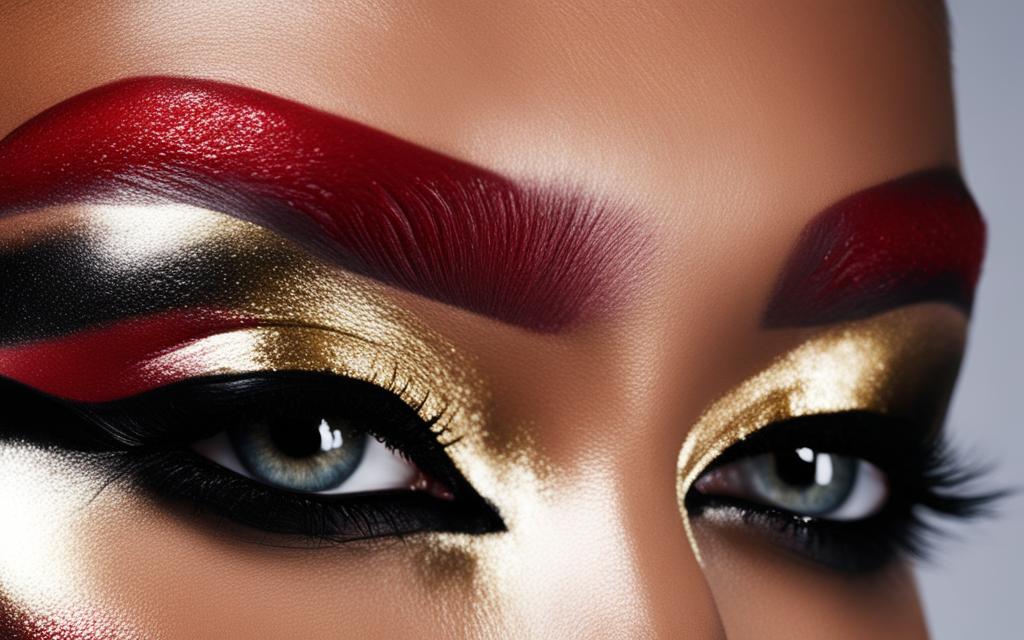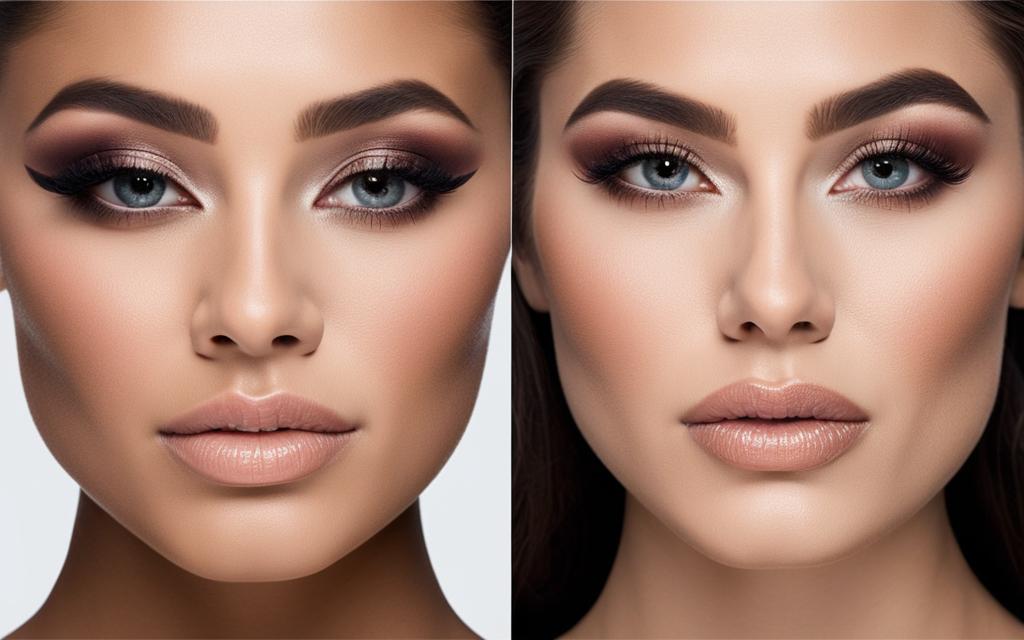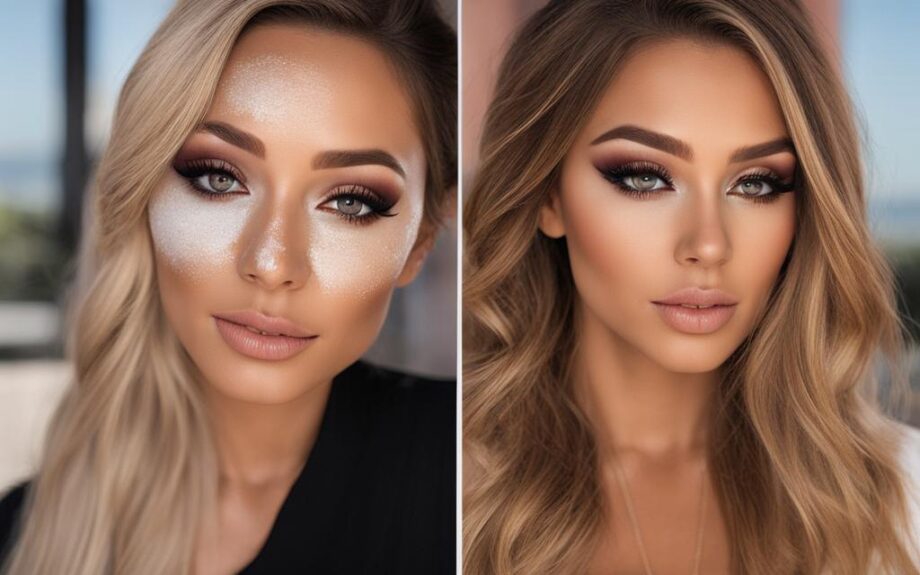Cream makeup and grease makeup are two popular types of makeup used for various beauty routines and special effects. Understanding the differences between them can help you make an informed decision about which one is best suited for your needs. Let’s explore the key characteristics of cream and grease makeup.
Key Takeaways:
- Cream makeup and grease makeup are two popular types of makeup with different characteristics.
- Cream makeup offers versatility, blendability, and hydration, making it suitable for various purposes and dry skin.
- Grease makeup provides bold colors, long-lasting wear, and water-resistance, making it ideal for dramatic stage looks and special effects.
- Consider your specific needs, skin type, desired coverage, and application requirements when choosing between cream and grease makeup.
- Experiment and practice to determine which makeup type works best for you.
Cream Makeup: Benefits and Application
Cream makeup is a versatile option that is available in tubes or palettes. It has a creamy texture and can be applied with fingers, sponges, or brushes. Some of the key benefits of cream makeup include:
- Versatility: Cream makeup can be used as foundation, concealer, highlighter, blush, eyeshadow, and even lip color, making it a multipurpose product for your beauty routine.
- Easy blendability: The creamy consistency of cream makeup allows it to blend effortlessly into the skin, creating a seamless and natural-looking finish.
- Buildable coverage: You can easily build up the coverage of cream makeup by layering it, allowing you to achieve the desired level of coverage for your skin.
- Hydrating properties: Cream makeup often contains moisturizing ingredients, making it a great choice for those with dry skin as it provides additional hydration.
When applying cream makeup, it’s important to prepare your skin by cleansing and moisturizing it beforehand. This ensures a smooth canvas for the makeup and helps it adhere better to the skin. To apply cream makeup:
- Start by dabbing a small amount of cream makeup onto the desired areas of your face.
- Gently blend the makeup using your fingers, a makeup sponge, or a brush. Make sure to blend it evenly for a seamless finish.
- If needed, layer the cream makeup to build up the coverage or intensity of the color.
- Once applied, you can set the cream makeup with translucent powder to help it last longer and prevent any creasing.
Removing cream makeup is relatively easy with various methods available:
- Use a makeup remover specifically designed for removing cream makeup. Apply the remover to a cotton pad and gently wipe away the makeup.
- Oil-based cleansers can also be effective in removing cream makeup. Massage the cleanser onto your skin, focusing on areas with makeup, and rinse with warm water.
- Alternatively, you can use baby wipes or micellar water to remove the makeup. Gently wipe the wipes or a cotton pad soaked in micellar water across your skin to lift away the cream makeup.
Overall, cream makeup offers a range of benefits and is a popular choice for its versatility, blendability, buildable coverage, and hydrating properties. Whether you’re going for a natural everyday look or a more glamorous makeup style, cream makeup can help you achieve the desired effect.
Grease Makeup: Benefits and Application
Grease makeup is a beloved choice among clowns and in theatrical performances. It is a heavy and thick makeup that typically uses oil as its base, resulting in high pigmentation and long-lasting wear. Grease makeup is renowned for its bold and vibrant colors, making it the perfect tool for creating dramatic stage looks and captivating special effects in film and television productions.
Grease makeup is the go-to option for performers who want to make a statement with their appearance.
The thick texture of grease makeup can pose a challenge when it comes to achieving an even application. However, its easy blending capabilities make it a favorite among makeup enthusiasts. Inexpensive brushes are often used to apply grease makeup, allowing for effortless blending and smooth transitions between colors.
One of the standout features of grease makeup is its water-resistance, which makes it highly suitable for performances involving water or rain. No matter the conditions, grease makeup will hold up and maintain its vibrant look throughout the show.
While grease makeup offers numerous benefits, it does come with a few considerations. The heaviness of the makeup can make it feel uncomfortable on the skin, especially during extended wear. Proper skill and technique are required to achieve the desired look and ensure an even application.
Grease makeup demands expertise and precision to achieve professional-looking results.
Removing grease makeup can also be a challenge. Due to its thick and long-lasting formula, specialized removers or techniques may be necessary to ensure complete removal without causing any skin irritation.

| Pros | Cons |
|---|---|
| High pigmentation | Heavy feel on the skin |
| Long-lasting wear | Challenging to apply evenly |
| Easily blendable | Requires skill for application |
| Water-resistant | May be difficult to remove |
Despite its challenges, grease makeup remains a favorite among performers for its ability to create show-stopping looks that leave a lasting impression on the audience.
Comparing Cream and Grease Makeup
When it comes to makeup, there are two popular options that often come to mind: cream and grease makeup. While they may serve a similar purpose of enhancing our appearance, there are several differences between them that are worth exploring.
Cream Makeup: Versatility and Hydration
Cream makeup, as the name suggests, has a creamy texture and is water-based. It is known for its versatility and easy blendability. Cream makeup can be applied with fingers, sponges, or brushes, allowing for different levels of coverage and a smooth finish.
One of the key advantages of cream makeup is its hydrating properties, making it a suitable choice for those with dry skin. It provides additional moisture and helps to prevent the makeup from settling into fine lines or emphasizing dry patches.
Cream makeup can be used for various purposes, including foundation, concealer, highlighter, blush, eyeshadow, and lip color. It allows for layering, giving you greater control in color packing and intensity. Additionally, cream makeup dries faster compared to grease makeup.
Grease Makeup: Intensity and Endurance
On the other hand, grease makeup is oil-based and has a thicker consistency. It is commonly used by clowns and in theatrical performances to create bold and vibrant looks. Grease makeup is known for its high pigmentation, offering intense and long-lasting color payoff.
Grease makeup sets with the help of translucent powder, which helps to seal the product and increase its staying power. This makes it ideal for performances or events where you need your makeup to last for extended periods, even under hot lights or in humid environments.
Despite its thick texture, grease makeup is surprisingly easy to blend, allowing for seamless transitions between different colors and creating stunning special effects. It can be applied with brushes or sponges and is typically more affordable compared to cream makeup.
Key Differences: Cream vs Grease Makeup
| Cream Makeup | Grease Makeup |
|---|---|
| Creamy texture | Thick consistency |
| Water-based | Oil-based |
| Requires layers for full coverage | More pigmented |
| Dries faster | Sets with translucent powder |
| Easily layered for color packing | Known for blendability |
| Hydrating properties, suitable for dry skin | May feel heavy and oily on the skin |
| Washed off with soap and water or makeup removing wipes | Requires specialized removers or techniques for removal |
Both cream and grease makeup have their own unique characteristics and advantages. Cream makeup offers versatility, easy blending, and hydration, making it a great choice for everyday use and dry skin. On the other hand, grease makeup provides intense pigmentation and endurance, making it perfect for theatrical performances or events where long-lasting color is required.
When deciding between cream and grease makeup, consider your specific needs, skin type, and desired outcome. Experimentation and practice can help you find the right balance and achieve the desired look for any occasion.
Choosing the Right Makeup for You
When deciding between cream and grease makeup, it’s important to consider your specific needs and preferences.
If you prefer a versatile option that can be used for various purposes and provides a smooth, even finish, cream makeup may be the better choice.
On the other hand, if you require bold and vibrant colors, long-lasting wear, and water-resistance, grease makeup might be more suitable.
Consider your skin type, the desired level of coverage, and the specific application requirements before making a decision.

Key Considerations:
- Skin Type: Cream makeup is often recommended for those with dry skin due to its hydrating properties, while grease makeup may feel heavy and oily on the skin.
- Coverage: Cream makeup usually requires layers for full coverage and offers the ability to build up color, whereas grease makeup is highly pigmented and sets with translucent powder.
- Application: Cream makeup is easily blendable and can be applied with fingers, sponges, or brushes, while grease makeup may require specialized techniques and brushes due to its thick texture.
By considering these factors and the pros and cons of each type of makeup, you can make an informed decision that suits your individual preferences and needs.
Tips for Using and Removing Cream and Grease Makeup
To achieve the best results with cream makeup, it is essential to follow the right application techniques. Here are some tips to help you with cream makeup application:
- Prepare your skin: Cleanse and moisturize your skin before applying cream makeup. This step will ensure a smooth canvas for makeup application.
- Choose the right tools: Use brushes, sponges, or your fingertips for applying cream makeup. These tools will help in achieving an even and seamless application.
- Apply in thin, even layers: Start with a small amount of cream makeup and build up the coverage gradually. This technique will prevent a heavy and cakey appearance.
- Blend carefully: Take your time to blend the cream makeup thoroughly. This step will help in achieving a natural and flawless finish.
- Set with powder or setting spray: To enhance the longevity of your cream makeup, set it with a translucent powder or a setting spray. This step will help in preventing smudging and prolonging the wear time.
When it comes to removing cream makeup, several methods can be employed:
- Makeup remover: Use a gentle and effective makeup remover to dissolve and remove the cream makeup from your skin. Look for removers that are specifically designed for face makeup removal.
- Oil-based cleansers: Another option is to use oil-based cleansers, as they can effectively break down the creamy texture of the makeup.
- Baby wipes: In a pinch, baby wipes can also be used to remove cream makeup. Ensure to choose wipes that are gentle and suitable for your skin.
- Micellar water: Micellar water is an excellent option for removing cream makeup, as it is gentle yet effective in eliminating makeup residue.
When it comes to grease makeup application, a few techniques should be kept in mind:
- Use brushes or sponges: Apply grease makeup using brushes or sponges. These tools will help in achieving a precise and controlled application.
- Be cautious of the thick texture: Grease makeup has a thick texture, so take your time to work it into the skin evenly. This step will prevent any patchiness or unevenness.
Removing grease makeup can be a bit more challenging compared to cream makeup. Here are some tips:
- Specialized removers: Look for specialized removers designed specifically for grease makeup. They are formulated to effectively dissolve and remove heavy makeup.
- Techniques: Certain techniques, such as using warm water and gentle scrubbing, can help in breaking down grease makeup. Be careful not to be too harsh on your skin while removing the makeup.
| Application | Cream Makeup | Grease Makeup |
|---|---|---|
| Texture | Creamy | Thick |
| Method | Brushes, sponges, or fingertips | Brushes or sponges |
| Blendability | Easy | Moderate |
| Buildable Coverage | Yes | No |
| Hydrating Properties | Yes | No |
| Removal | Makeup remover, oil-based cleansers, baby wipes, or micellar water | Specialized removers or techniques |
Conclusion
After exploring the benefits and applications of cream and grease makeup, it is clear that they cater to different needs and preferences. Cream makeup offers versatility and ease of blending, making it ideal for achieving a natural look and catering to various makeup routines. On the other hand, grease makeup provides bold and vibrant colors with long-lasting wear, making it a popular choice for theatrical performances and dramatic stage looks.
When deciding between cream and grease makeup, it is vital to consider your personal preferences, skin type, and specific makeup requirements. Those with dry skin may benefit from the hydrating properties of cream makeup, while those seeking intense pigmentation and water-resistance may opt for grease makeup. Experimentation and practice can help you determine which type works best for you.
Remember, the key differences highlighted in this article, such as water-based vs. oil-based formulas, blendability, and finish, will assist you in making an informed decision. Ultimately, it is up to you to decide which type of makeup aligns with your individual style and needs. So go ahead, explore the wonderful world of cream and grease makeup, and discover the perfect choice for your unique beauty routine.
FAQ
What are the differences between cream makeup and grease makeup?
Cream makeup is water-based, while grease makeup is oil-based. Cream makeup provides versatility, easy blendability, buildable coverage, and hydrating properties, making it suitable for various purposes. Grease makeup, on the other hand, is known for its bold colors, high pigmentation, long-lasting wear, and water resistance, making it ideal for theatrical performances and special effects.
What are the benefits of using cream makeup?
Cream makeup offers a smooth, even finish and can be used as foundation, concealer, blush, eyeshadow, and more. It is versatile, easy to blend, and provides hydrating properties, making it suitable for those with dry skin.
How should cream makeup be applied?
Cream makeup can be applied with fingers, sponges, or brushes. It is recommended to prepare the skin by cleansing and moisturizing it beforehand. Thin, even layers of cream makeup should be applied, blending carefully for a natural look. Setting the makeup with powder or a setting spray can prolong its wear. To remove cream makeup, options include makeup remover, oil-based cleansers, baby wipes, or micellar water.
What are the benefits of using grease makeup?
Grease makeup provides bold and vibrant colors, high pigmentation, and long-lasting wear. It is ideal for creating dramatic stage looks and special effects in film and television. Grease makeup is also water-resistant, making it suitable for performances involving water or rain.
How should grease makeup be applied?
Grease makeup can be applied with brushes or sponges. While its thick texture can be challenging to apply evenly, grease makeup offers easy blending. It is important to be cautious of its heavy feel on the skin. When removing grease makeup, specialized removers or techniques may be necessary.
How do cream and grease makeup differ?
Cream makeup is water-based, while grease makeup is oil-based. Cream makeup is more easily layered, dries faster, and is suitable for those with dry skin due to its hydrating properties. Grease makeup is more pigmented, sets with translucent powder, and offers long-lasting wear and water resistance, but may feel heavy and oily on the skin.
How do I choose the right makeup for me?
When choosing between cream and grease makeup, consider factors such as your skin type, desired level of coverage, and specific application requirements. Cream makeup is versatile and offers a smooth finish, while grease makeup provides bold colors and long-lasting wear. Experimentation and practice can help determine which type works best for you.
Any tips for using and removing cream and grease makeup?
Before applying cream makeup, prepare the skin by cleansing and moisturizing it. Use brushes, sponges, or fingertips to apply thin, even layers and blend carefully. Setting the makeup with powder or a setting spray can help it last longer. To remove cream makeup, use makeup remover, oil-based cleansers, baby wipes, or micellar water. For grease makeup, apply it with brushes or sponges and be cautious of its thick texture. Specialized removers or techniques may be necessary to remove grease makeup.
What should I consider when deciding between cream and grease makeup?
Consider your specific needs and preferences, such as the desired level of coverage, the type of look you want to achieve, and your skin type. Cream makeup offers versatility and easy blendability, while grease makeup provides bold colors and long-lasting wear. Understanding the key differences can help you make an informed decision.
